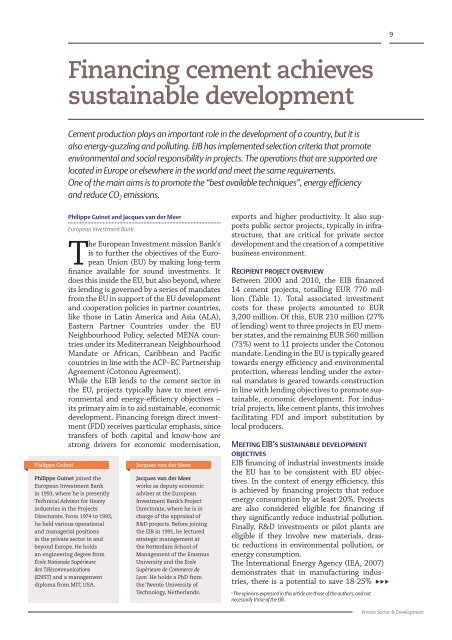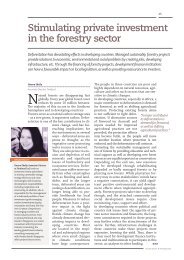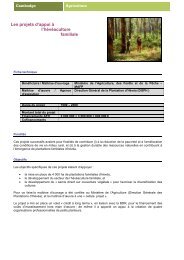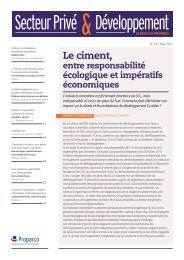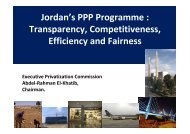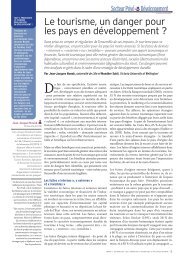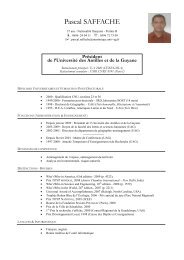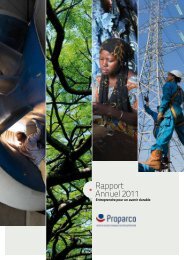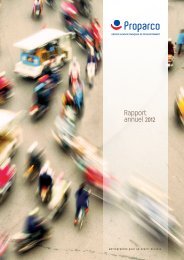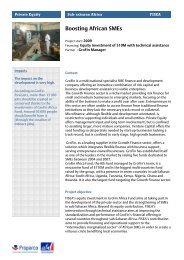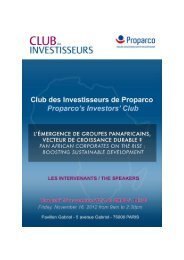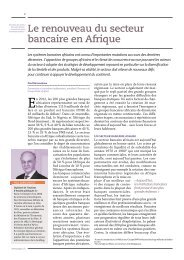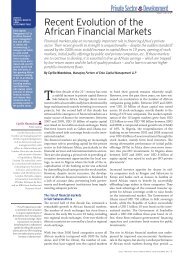Download Philippe Guinet and Jacques van der Meer's ... - Proparco
Download Philippe Guinet and Jacques van der Meer's ... - Proparco
Download Philippe Guinet and Jacques van der Meer's ... - Proparco
Create successful ePaper yourself
Turn your PDF publications into a flip-book with our unique Google optimized e-Paper software.
9<br />
Financing cement achieves<br />
sustainable development<br />
Cement production plays an important role in the development of a country, but it is<br />
also energy-guzzling <strong>and</strong> polluting. EIB has implemented selection criteria that promote<br />
environmental <strong>and</strong> social responsibility in projects. The operations that are supported are<br />
located in Europe or elsewhere in the world <strong>and</strong> meet the same requirements.<br />
One of the main aims is to promote the “best available techniques”, energy efficiency<br />
<strong>and</strong> reduce CO 2 emissions.<br />
<strong>Philippe</strong> <strong>Guinet</strong><br />
<strong>Philippe</strong> <strong>Guinet</strong> <strong>and</strong> <strong>Jacques</strong> <strong>van</strong> <strong>der</strong> Meer<br />
European Investment Bank 1<br />
The European Investment mission Bank's<br />
is to further the objectives of the European<br />
Union (EU) by making long-term<br />
finance available for sound investments. It<br />
does this inside the EU, but also beyond, where<br />
its lending is governed by a series of m<strong>and</strong>ates<br />
from the EU in support of the EU development<br />
<strong>and</strong> cooperation policies in partner countries,<br />
like those in Latin America <strong>and</strong> Asia (ALA),<br />
Eastern Partner Countries un<strong>der</strong> the EU<br />
Neighbourhood Policy, selected MENA countries<br />
un<strong>der</strong> its Mediterranean Neighbourhood<br />
M<strong>and</strong>ate or African, Caribbean <strong>and</strong> Pacific<br />
countries in line with the ACP–EC Partnership<br />
Agreement (Cotonou Agreement).<br />
While the EIB lends to the cement sector in<br />
the EU, projects typically have to meet environmental<br />
<strong>and</strong> energy-efficiency objectives –<br />
its primary aim is to aid sustainable, economic<br />
development. Financing foreign direct investment<br />
(FDI) receives particular emphasis, since<br />
transfers of both capital <strong>and</strong> know-how are<br />
strong drivers for economic mo<strong>der</strong>nisation,<br />
<strong>Philippe</strong> <strong>Guinet</strong> joined the<br />
European Investment Bank<br />
in 1993, where he is presently<br />
Technical Advisor for Heavy<br />
industries in the Projects<br />
Directorate. From 1974 to 1993,<br />
he held various operational<br />
<strong>and</strong> managerial positions<br />
in the private sector in <strong>and</strong><br />
beyond Europe. He holds<br />
an engineering degree from<br />
École Nationale Supérieure<br />
des Télécommunications<br />
(ENST) <strong>and</strong> a management<br />
diploma from MIT, USA.<br />
<strong>Jacques</strong> <strong>van</strong> <strong>der</strong> Meer<br />
<strong>Jacques</strong> <strong>van</strong> <strong>der</strong> Meer<br />
works as deputy economic<br />
adviser at the European<br />
Investment Bank’s Project<br />
Directorate, where he is in<br />
charge of the appraisal of<br />
R&D projects. Before joining<br />
the EIB in 1991, he lectured<br />
strategic management at<br />
the Rotterdam School of<br />
Management of the Erasmus<br />
University <strong>and</strong> the École<br />
Supérieure de Commerce de<br />
Lyon. He holds a PhD from<br />
the Twente University of<br />
Technology, Netherl<strong>and</strong>s.<br />
exports <strong>and</strong> higher productivity. It also supports<br />
public sector projects, typically in infrastructure,<br />
that are critical for private sector<br />
development <strong>and</strong> the creation of a competitive<br />
business environment.<br />
Recipient project overview<br />
Between 2000 <strong>and</strong> 2010, the EIB financed<br />
14 cement projects, totalling EUR 770 million<br />
(Table 1). Total associated investment<br />
costs for these projects amounted to EUR<br />
3,200 million. Of this, EUR 210 million (27%<br />
of lending) went to three projects in EU member<br />
states, <strong>and</strong> the remaining EUR 560 million<br />
(73%) went to 11 projects un<strong>der</strong> the Cotonou<br />
m<strong>and</strong>ate. Lending in the EU is typically geared<br />
towards energy efficiency <strong>and</strong> environmental<br />
protection, whereas lending un<strong>der</strong> the external<br />
m<strong>and</strong>ates is geared towards construction<br />
in line with lending objectives to promote sustainable,<br />
economic development. For industrial<br />
projects, like cement plants, this involves<br />
facilitating FDI <strong>and</strong> import substitution by<br />
local producers.<br />
Meeting EIB’s sustainable development<br />
objectives<br />
EIB financing of industrial investments inside<br />
the EU has to be consistent with EU objectives.<br />
In the context of energy efficiency, this<br />
is achieved by financing projects that reduce<br />
energy consumption by at least 20%. Projects<br />
are also consi<strong>der</strong>ed eligible for financing if<br />
they significantly reduce industrial pollution.<br />
Finally, R&D investments or pilot plants are<br />
eligible if they involve new materials, drastic<br />
reductions in environmental pollution, or<br />
energy consumption.<br />
The International Energy Agency (IEA, 2007)<br />
demonstrates that in manufacturing industries,<br />
there is a potential to save 18-25%<br />
1<br />
The opinions expressed in this article are those of the authors, <strong>and</strong> not<br />
necessarily those of the EIB.<br />
Private Sector & Development
10<br />
Financing cement achieves sustainable development<br />
Cement,<br />
confronting<br />
ecological<br />
responsibility<br />
<strong>and</strong> economic<br />
imperatives<br />
in primary energy consumption (roughly<br />
750 Mtoe/yr) <strong>and</strong> 19-32% in CO 2 emissions<br />
(an average 2650 Mt of CO 2 /yr) from adoption<br />
of best practice technologies. Whereas this<br />
IEA study illustrates the potential for energy<br />
efficiency investments <strong>and</strong> CO 2 abatement,<br />
the EIB looks at the economic performance<br />
of the investments. For instance, although it<br />
may seem cheaper to invest in emission reductions<br />
from power plants rather than investing<br />
in energy efficient buildings, the cost over the<br />
latter’s life may be much lower, resulting in the<br />
latter being more attractive. By promoting <strong>and</strong><br />
supporting these higher-cost investments,<br />
multilateral financiers like the EIB can play a<br />
catalytic role.<br />
With the EIB’s external m<strong>and</strong>ates, efforts are<br />
directed at fostering private sector-led development<br />
that promotes economic growth <strong>and</strong><br />
has a positive economic <strong>and</strong> social impact on<br />
the wi<strong>der</strong> community <strong>and</strong> region. And this has<br />
been the main justification financing cement<br />
projects outside the EU. In the stages of a<br />
country’s economic development, production<br />
shifts from mainly unskilled, manual activities<br />
to basic industrial activities that cater for the<br />
exp<strong>and</strong>ing infrastructure – construction sectors<br />
<strong>and</strong> heavy industries. Local cement production<br />
is therefore important to regional<br />
infrastructure development, which is essential<br />
in reducing poverty, promoting social equity<br />
<strong>and</strong> enhancing a nation or a region’s industrial<br />
competitiveness.<br />
This justifies international financing in support<br />
of exp<strong>and</strong>ing local cement-producing<br />
capacity. The relation between GDP <strong>and</strong><br />
cement dem<strong>and</strong> is clearly illustrated in the Figure<br />
1, showing the steep increase in developing<br />
economies <strong>and</strong> the stabilisation of dem<strong>and</strong> in<br />
Western economies. When countries achieve<br />
higher levels of economic development, production<br />
<strong>and</strong> therefore capital investment<br />
shifts to higher-value added goods (machinery,<br />
transport equipment), <strong>and</strong> economies become<br />
more service-oriented.<br />
Technical <strong>and</strong> economic consi<strong>der</strong>ations<br />
Once the EIB’s lending criteria have been met,<br />
a due diligence is un<strong>der</strong>taken, which takes into<br />
account the characteristics of the industry <strong>and</strong><br />
addresses the technical <strong>and</strong> economic un<strong>der</strong>pinnings<br />
of the project. For projects outside<br />
the EU, the due diligence incorporates social<br />
<strong>and</strong> economic development effects.<br />
Given the EIB’s commitment to protecting<br />
the environment <strong>and</strong> promoting sustainable<br />
development, it places an emphasis on the use<br />
of best available technologies 2 (BAT) in choosing<br />
processes <strong>and</strong> equipment. It also encourages<br />
using alternative fuels such as waste fuels<br />
(spent oils, tyres, animal feeds, pet coke, biomass,<br />
etc.) <strong>and</strong> reducing the CO 2 component of<br />
the electricity used to operate the plant.<br />
A lot of consi<strong>der</strong>ation is given to using alternative<br />
cementitious materials as a substitute for<br />
clinker. The EIB has instances of this in its portfolio,<br />
with up to 50% of steel slags being used<br />
in the Cementir plant in Taranto (Italy), <strong>and</strong><br />
the promotion of modifications of the national<br />
technical specifications for cement by the Syrian<br />
plant, in or<strong>der</strong> to allow the incorporation<br />
of up to 25% of puzolan. The EIB has defined<br />
an internal methodology (based on international<br />
greenhouse gas accounting st<strong>and</strong>ards)<br />
to assess the carbon footprint of its industrial<br />
projects, by calculating baseline emissions <strong>and</strong><br />
absolute project emissions.<br />
2<br />
Best available technology (BAT) is the ad<strong>van</strong>ced method used in industrial<br />
production that limits the emission of pollutants.<br />
TABLEAU 1: EIB LENDING OPERATIONS IN CEMENT SECTOR (2000-2010)<br />
Year Country Project name Cost (M EUR)<br />
2000 Bangladesh Lafarge Suma Cement Plant Construction of a cement plant near Chhatak 247<br />
2002<br />
Bosnia-<br />
Herzegovina<br />
Lukavac Cement Factory<br />
Mo<strong>der</strong>nisation <strong>and</strong> new production line at Lukavac,<br />
nord of Sarajevo<br />
2002 Algeria Algerian Cement Company Construction of cement plant near M’sila 284<br />
2002 Tunisia Cimenterie CAT<br />
Mo<strong>der</strong>nisation <strong>and</strong> capacity extension<br />
of a cement plant near Tunis<br />
2003 Portugal CIMPOR Cimentos Mo<strong>der</strong>nizaçao Mo<strong>der</strong>nisation of three cement plant in Portugal 120<br />
2004 Algeria Algerian Cement Company Capacity extension of cement plant near M’sila 157<br />
2005 Nigeria Dangote Cement Construction of a cement plant 605<br />
2006 Pakistan DG Khan cement Construction of a cement plant near Chakwal 208<br />
2008 Ethiopia Derba Midroc Cement Construction of a cement plant at 70km from Addis Abeba 251<br />
2009 Turkey CIMPOR Yibitas Ankara Construction of a clinker line near Ankara 127<br />
2009 Namibia Ohorongo Cement Construction of a small cement plant near Addis Abeba 242<br />
2009 Syria Syrian Cement Company Construction of a cement plant near Aleppo 127<br />
2009 Spain Cementos Molins Energy Efficiency project at a cement plant near Sant Vincenç 506<br />
2010 Italy Cementir Taranto Energy Efficiency project at a cement plant in Taranto 208<br />
Source : BEI, 2011<br />
75<br />
43<br />
www.proparco.fr
11<br />
FIGURE 1: LINK BETWEEN GDP GROWTH AND CEMENT CONSUMPTION<br />
800<br />
6 000<br />
700<br />
600<br />
1950-2008 CAGR:<br />
Gross Domectic Product: 3.4%<br />
Cement consumption: 2.4%<br />
5 000<br />
1950-2008 CAGR:<br />
Gross Domectic Product: 4.5%<br />
Cement consumption: 7%<br />
500<br />
EU15, USA <strong>and</strong> Japan<br />
4 000<br />
Rest of the world<br />
400<br />
3 000<br />
300<br />
2 000<br />
200<br />
100<br />
0<br />
50<br />
535659626568<br />
71747780838689929598010407<br />
1980 = 100<br />
1 000<br />
0<br />
50<br />
535659626568<br />
71747780838689929598010407<br />
Nota bene: CAGR means Compound Annual Growth Rate<br />
Source: Italcimenti<br />
For the construction <strong>and</strong> equipment used in<br />
the plant, the EIB has established criteria in<br />
terms of cost of investment, timely implementation<br />
<strong>and</strong> reliability of operation, to ensure<br />
that design, procurement <strong>and</strong> management<br />
are effectively carried out in the project. These<br />
criteria have resulted in the Bank financing<br />
projects using Chinese technology. This may<br />
seem controversial, as it does not promote<br />
EU technology, <strong>and</strong> some Chinese equipment<br />
incorporates copied Western technology; however,<br />
in some instances, these choices of technology<br />
have proved favourable to projects. For<br />
instance, without compromising on the quality<br />
of equipment supplied, the low-cost delivery<br />
of equipment has permitted the improved<br />
profitability of a project in un<strong>der</strong>taken in difficult<br />
circumstances in Ethiopia.<br />
For greenfield cement plants in the EU a full<br />
social <strong>and</strong> environmental impact assessment,<br />
including public consultations has to be un<strong>der</strong>taken.<br />
The EIB applies this criterion to all its<br />
operations worldwide, on all plant aspects. This<br />
results in choosing best available technologies<br />
in the design of projects. The social impacts of<br />
projects are consistently taken into account;<br />
in particular, issues such as resettlements of<br />
previous occupants of the sites, occupational<br />
health <strong>and</strong> safety, <strong>and</strong> engagement with communities<br />
are carefully monitored. Examples of<br />
this in EIB-financed projects can be found in<br />
Syria <strong>and</strong> Ethiopia.<br />
Cement is the principal material used in construction<br />
(buildings <strong>and</strong> large infrastructure),<br />
<strong>and</strong> dem<strong>and</strong> for cement is tightly linked to<br />
the social <strong>and</strong> economic development of countries.<br />
Investments in local cement production<br />
stimulate competition <strong>and</strong> often create surpluses,<br />
reducing local prices <strong>and</strong> improving<br />
product quality. In developing countries, due<br />
to deficient local capacity, it may release pentup<br />
dem<strong>and</strong>, resulting in development. Examples<br />
of significant cement price reduction<br />
(of up to 30%) <strong>and</strong> an immediate increase<br />
in dem<strong>and</strong> (of up to 10%) were the results<br />
of projects financed in Bangladesh, Nigeria<br />
<strong>and</strong> Ethiopia. Thus, in addition to the financial<br />
un<strong>der</strong>pinnings, such direct externalities<br />
are incorporated as the economic returns of a<br />
project. Simultaneously, the EIB evaluates the<br />
environmental impact in its economic assessment,<br />
including a shadow price for greenhouse<br />
gas (GHG) emissions in the calculation<br />
of the project’s economic rate of return. The<br />
Bank’s current shadow prices for carbon are<br />
based upon an economic price of carbon proposed<br />
in 2006 by the Stockholm Environment<br />
Institute (SEI) to the Bank for its economic<br />
analysis of projects. SEI recommended values<br />
start from EUR 25/t of CO 2 emitted in 2010<br />
- increasing by EUR 1 every year - to reach<br />
EUR 45/t of CO 2 in 2030 for the central range<br />
(baseline). The shadow prices of other GHG<br />
is based upon their global warming potential<br />
factors (where CO 2 = 1), as proposed by the<br />
Intergovernmental Panel on Climate Change.<br />
The EIB has continued its financial support of<br />
the cement industry, an energy- <strong>and</strong> carbon<br />
emissions-intensive sector, by consi<strong>der</strong>ing its<br />
important impact on the economic development<br />
of countries. However, EIB-financing is<br />
increasingly being challenged because of its<br />
imperative to calculate the absolute <strong>and</strong> relative<br />
footprints of projects.<br />
References / IEA, 2007. Tracking Industrial Energy Efficiency <strong>and</strong> CO2 Emissions, report.<br />
Private Sector & Development


